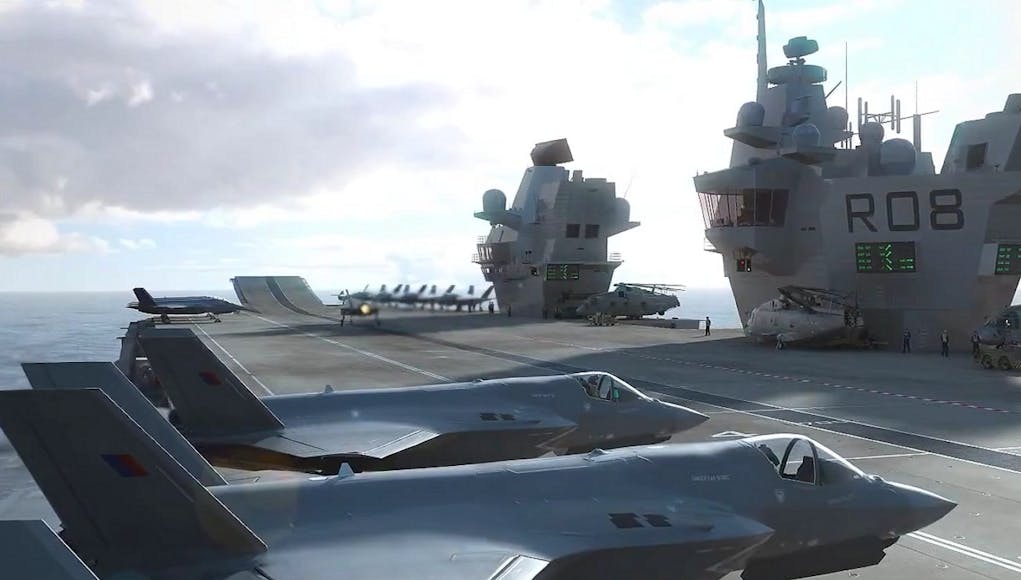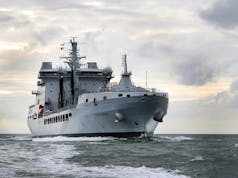The Ministry of Defence has examined the feasibility of deploying Carrier Strike before December 2020 and advised against this in anything other than an operational emergency.
According to a report on carrier strike by the National Audit Office:
“Increasing awareness of Carrier Strike as the equipment is completed may lead to demand for it to be deployed earlier than December 2020. The first carrier is expected to sail during 2017 and the first squadron of jets will be flying from the UK in 2018.
But before the Department can operate the two together as Carrier Strike, there will be an intensive period of training, trials and further work. This period is crucial to ensure that crews can operate the equipment safely and to give the Department confidence the capability works as intended. While the equipment could be used together before these trials are complete, this could carry safety risks or limit how the equipment could be used.
It would also disrupt the Department’s planned schedule. The Department has examined the feasibility of deploying Carrier Strike before December 2020 and advised against this in anything other than an operational emergency.”
The NAO also found that there is ‘increasing pressure on a few highly trained personnel to operate the capability’. There is a shortage of military personnel, running at 4% below a target strength of 145,560.
Staffing gaps include engineering roles and warfighting specialists in the Royal Navy and engineering, intelligence and some aircrew cadres in the RAF. To minimise the impact of these gaps on Carrier Strike, the Ministry of Defence is prioritising it and carrying out targeted recruitment.
Captain Jerry Kyd, commander of HMS Queen Elizabeth, commented on the initial deployment and the gradual increase in air wing numbers:
“We are constrained by the F-35 buy rate even though that was accelerated in SDSR in 2015, so initial operating capability numbers in 2020 are going to be very modest indeed.
We will flesh it out with helicopters, and a lot depends on how many USMC F-35s come on our first deployment in 2021. But by 2023, we are committed to 24 UK jets onboard, and after that it’s too far away to say.”
In addition to the joint force of Royal Air Force and Royal Navy F-35Bs and their pilots, the air wing is expected to be composed of a ‘Maritime Force Protection’ package of nine anti-submarine Merlin HM2 and four or five Merlin for airborne early warning; alternatively a ‘Littoral Manoeuvre’ package could include a mix of RAF Chinooks, Army Apaches, Merlin HC4 and Wildcat HM2. We understand that vessel would still carry at least one F-35 squadron aboard in such circumstances to offer air defence as well as support to the helicopter assault activities.
The Crowsnest AEW&C aircraft will come from a number of the embarked Merlins (any of which can be fitted with the sensor package), the number again scaling with requirements.
Around the time the first carrier deploys operationally, the UK will have 42 F-35 aircraft, with 24 being front-line fighters and the remaining 18 will be used for training (at least 5 on the OCU), be in reserve or in maintenance.
Recently, the Ministry of Defence confirmed plans for the deployment of American F-35 aircraft alongside British jets aboard HMS Queen Elizabeth.
The addition of US Marine Corps aircraft will see HMS Queen Elizabeth sail with 24 or so F-35Bs in addition to around 14 or so helicopters for her maiden deployment. It is understood that the US aircraft will augment British jets on coalition operations.














Where is to going to sail to fantasy island?
No, probably the Gulf.. Look forward to seeing the first deployment
Thing is John if it’s the Gulf then the actual requirement for escorts, surface or sub-sea is minimal, both in itself and in terms of other countries escorts. It’s the carrier itself is the big ticket item, and the UK would be providing one. Who else would, apart from the US? Scotland? (I couldn’t resist that). It’s by no means certain the C de G would be there.
And if there were as few as 3 F35-Bs aboard, that’s 3 more than currently. The key thing is that the first arrivals for the RAF be the F35-B variant, so they can work in co-operation with the Royal Navy ones – and have trained in that role.
I’m cluttering up this board but when my dander is up – it’s up.
What needs to be looked at is the history of missions in the Gulf. How often was it a single flight of 2 Tornados, and how often a full squadron – or 2 full squadrons? It’s the former, 2 or 4, and all it means if there were a limited number of F35-Bs on board is that they’d be running hot. Well, how novel, how unusual for that to happen with the Navy, Air Force and Army!
persian Gulf *
Lets hope it can handle warm water.
Or as the Arabs call it the Arabian gulf
It’s all a bit glass half empty with NAO which is their job, and half full with the MOD – which is their job.
Personally I’m half full, if the capability is there for an emergency operation, then it’s there, as the operation continues new arrivals can be ferried out, skills will grow rapidly “under fire”, and perhaps the key thing is that there aren’t still any dockyard workers on-board.
These things take time.
Was it not Hammond who slowed production speed of the QE a few ago to make short term savings?. No wonder she’s not going to be on time but training most certainly not be rushed or cut purely to rush her into full service.
No – it was Gordon brown
Remember the old joke about waiting for a bus? Well, we have all been waiting fifty years for a decent carrier and now two come along at the same time. Well…almost! Let’s be thankful that we are getting close to having a modern blue water capability for the first time in decades.
The budget may be even more if they have to employ retired sailors. They will need to install stannah stair lifts
The delay to the QE class and the under ordering of type 45s to just 6 hulls was the Blair Brown government’s fault. They used the savings to boost defence budgets to fight the Iraq and Afghan wars.
The rot set in under labour and then was compounded by Cameroon. Who scrapped Harriers and sent Ark Royal to scrap yard as well as 3x type 23s to Chile ( which we could really do with now) and scrapping our highly specialised type 22 batch 3 frigates.
All that is in the past we simply need more money to go into defence now. A new sdsr now! Cut foreign aid budget or alternatively have the foreign aid budget as a charitable fund that those wanting to contribute towards and those with spare cash can pay into.
The UK is rightly a very generous and kind country compared to most and we should still help others but not at the expense of our own public services and defence.